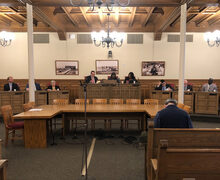Health and Science : Weighing in: Students, faculty discuss dangers of childhood obesity
As families become busier in today’s society, sitting down for a meal has become less realistic and unhealthy fast foods are now the easiest option. Cultural changes like these are believed to contribute to childhood obesity.
Michelle Bevilacqua, a sophomore nutrition major, said she sees childhood obesity as a major problem for today’s generation.
‘Children need to learn to eat healthier and become more active because it is just going to hurt them in the long run. Children are already starting to see the effects of having a poor diet by becoming obese and facing health issues such as diabetes,’ Bevilacqua said.
In 2008, the Centers for Disease Control and Prevention stated that more than one in three children was overweight or obese. Leigh Gantner, an assistant professor of nutrition and science dietetics in the David B. Falk College of Sport and Human Dynamics, said she is concerned with the factors that play into childhood obesity.
‘It’s not so much about the BMI as it is about what is contributing to general health problems,’ she said. ‘For example, consumption of the wrong types of foods and a lack of desire for kids to get outside and play.’
Get Healthy CNY, a monthlong campaign against childhood obesity, concentrates on the financial burden and negative health effects obesity can cause. The campaign, launched about two weeks ago, also strives to promote awareness of local options, such as food pantries and farmers markets, where parents can find healthier options for their children, according to the campaign’s website.
Obesity greatly increases one’s chances of developing cancer, depression, diabetes, arthritis and heart disease, and it decreases one’s life expectancy by 10 years, according to the campaign’s website.
Because it is hard to alter what children are eating at home, Gantner said she sees food manufacturers as a source for change in making convenience foods healthier.
‘Our lives won’t get less busy,’ she said. ‘This is work that needs to happen in making a partnership between food manufacturers and the public health to make sure families have access to healthier foods that are better for them, but still easier to prepare.’
Being obese can have annual financial burdens of up to $2,646 for men and $4,879 for women, according to the campaign’s website and a 2010 study conducted by George Washington University.
Kristina Mallon, a sophomore nutrition major, said she believes a family’s income is a major contribution to a child’s diet.
‘Low-income families will purchase whatever is available for their money. Lower cost items usually are less energy dense and contain more calories, sodium, cholesterol and trans fats,’ Mallon said.
More cultural issues contributing to childhood obesity include parents working outside the home, which reinforces the need for convenience foods, and the increased difficulty of getting to parks because of safety concerns, Gantner said.
The promotion of healthier lifestyles is best done through schools and education, Gantner said.
‘Most kids spend between six to eight, even nine, hours at school,’ Gantner said. ‘It’s important to bring physical education back into kids’ lives, offer healthier foods in cafeterias and vending machines, and have teachers model healthier lifestyles.’
Said Mallon: ‘If a mother only has a dollar to spend, she’s going to purchase something like a dollar hamburger from McDonald’s that will satisfy her child’s hunger before the head of lettuce at the supermarket.’
Published on February 27, 2012 at 12:00 pm





